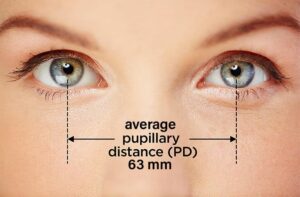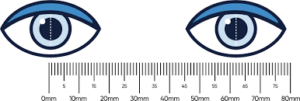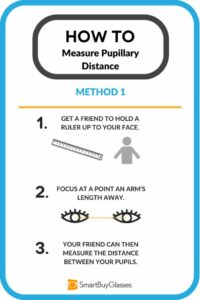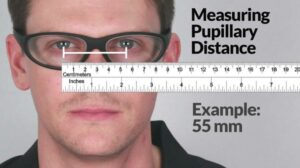Contents
What Is The Pupillary Distance (PD)?
Pupillary Distance (PD) means the distance between your pupils. This distance is measured to provide you with proper and correct glass so that the centre of the lens directly lies in front of the pupil. An optician will measure your Pupillary distance when you go to buy a pair of glasses. If you are buying your glasses online you can measure your PD online on your own.
The average pupillary distance of an adult is 63mm. However, this range varies from person to person according to their gender, and age. Women have a pupillary in between 51mm – 74mm. Whereas, men’s PD widely varies from 53mm to 77mm. children’s PD is much lesser. To conclude, this distance is not something you should assume while buying new glasses. Know your pupillary distance before buying eyeglasses to get a more comfortable fit.

Types of Pupillary Distance
There are two types of pupillary distance:
Monocular – Single-valued PD, people having the same distance between the nose and the centre of the pupil.
Binocular– Two-valued PD, people having irregular distance between the bridge of the nose and the centre of the pupil. Dual or binocular PD doesn’t reduce eyestrain therefore, it is recommended only to people with a lower prescription.
How To Measure Pupillary Distance (PD)?

Method 1- With A Mirror And mm Scale
You can measure your PD at home with just a mirror and an mm scale. Try to not use a normal ruler as it might not give you an accurate distance measurement. Use the millimeter ruler i.e., rulers that are specially designed to measure distance or there are rulers available to measure the PD, known as PD rulers. If possible, use the PD rulers for the best results.
- Stand 20cm away from the mirror.
- Put the one end of the millimeter scale on the centre of your left eye’s pupil. Then close your right eye.
- Look in the mirror then close your left eye and open your right eye.
- The number you see lining at the mm scale from your right eye is your Pupillary Distance.
Method 2– Go To An Optician
- Sit beside your optician at one arm distance while he/she is measuring your pupillary distance so that it is easy for them to mark the correct measurements. The optician should:
- Hold the ruler between the thumb and the index finger to have a firm grip.
- Be steady with their hands while measuring the distance or it might lead to error in the measurements.

- Measure with the ruler to align your eyes while the measurement is going on.
- Repeat the same procedure for the measurement of the other eye.
Method 3 –Using Your Old Eyeglasses
This is the simplest method to measure your PD. What you need is just an old eyeglass and a marker. The procedure to measure the PD is quite easy with this method.
- Focus on an object at a distance of 20feet away while wearing your eyeglasses.
- Close your right eye then mark the object at the point it appears on your lens.
- Mark the point on your other lens similarly.
- Measure the distance between these dots on your lens, this is your PD.
There are some other ways as well to measure pupillary distance. One of which is measuring your old glasses. However, it is a very complicated procedure. In order to get the measurements from your previous glasses, you need to send the glasses to the manufacturer so that they can give you exact measurements of your previous glasses. There are many bends and curves in the glasses that may give you the wrong results. Therefore, it has to be examined by the manufacturer. Secondly, if you are at your developing age, it is advised not to take the measurement from your previous glasses because your body develops as you grow old. Therefore, it will give you the wrong measurement and that might lead to improper fitting of the glasses.
Things To Remember While Calculating PD
The first and foremost reason to avoid taking your PD by yourself is that the calculation of PD will not be accurate. There are high chances of getting the wrong PD on your own. For taking the PD you need to sit in front of a mirror but all you can see in the Mirror is the reflection of the objects that you are using. This reflected image might give you the wrong results, as there are many cases where these types of errors are found.
There are chances of error if your mirror is convex or concave as they might give you a larger ruler image and then the measurement would get incorrect.
It is recommended to ask somebody like your family member or friends to check your measurements and make sure they calculate accurately. You can always go to an optician for the measurement, as they will give you the most accurate measurement.

Does Pupillary Distance Change With Age?
The pupillary distance changes as you grow older, because the size of your brain and eye socket grows along with the development of the body. This change only occurs in children as the body develops from childhood to adulthood. The change does not take place from adulthood to old age as our height and muscles do not grow anymore.
Therefore, it is advised to take a new PD every time you buy glasses for your child.
Visit our website Eyemantra.To book an appointment call +91-9711115191. Or mail us at [email protected].
We also offer various services like Retina Surgery, Specs Removal, Lasik Surgery, Squint, Cataract Surgery, Glaucoma Surgery, and much more.



